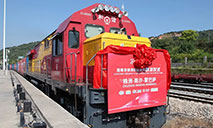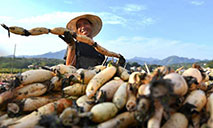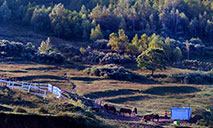Solar energy lights lives of herders on plateau in NW China
XINING, Oct. 5 (Xinhua) -- Every morning, Suo Qiyuan, a herder in northwest China's Qinghai Province, takes more than 300 sheep to graze inside a solar power station.
Located in a green industrial park in the Hainan Tibetan Autonomous Prefecture, the station was built in 2013 and designed to capitalize on the region's rich solar energy resources at an altitude of approximately 3,000 meters.
Over the years, it has become more than a supplier of clean power. It has also been an unexpected gift for local herders.
Suo, 40, used to lead a nomadic life. For more than 20 years, he moved his camp across the endless pasture, following his grass-seeking herd all year round.
He said that in 2018, a grazing ban began to take effect in the area to aid ecological protection efforts, and it affected Suo's life.
The local government soon took notice of Suo's predicament and invited him to graze his sheep in a solar power station belonging to the Qinghai branch of China Huaneng Group Co., Ltd.
Suo was puzzled at first, as the power station is located in an area that has long been impacted by desertification. "How can I herd sheep where there is no grass?"
The day after he visited the station, he moved his tent and sheep pen without hesitation.
The broad photovoltaic panels inside the power station, 1.5 meters above and parallel to the ground, allow sufficient space for vegetation growth and reduce evaporation from the land surface, according to Liu Guang, an official with the industrial park's administration.
At the same time, the regular cleaning of the panels provides extra water for the soil to absorb, eventually turning wasteland into grassland.
Monitoring data has shown that wind speeds in the park have decreased by 50 percent and soil water evaporation has decreased by 30 percent, while vegetation coverage has recovered to 80 percent.
As the grass grows taller, however, it can block the panels from the sun and pose a fire hazard in the winter. Weeding also increases company budgets.
These factors mean sheep and other livestock are welcome in the industrial park, which is now home to some 90 solar power plants.
According to Huaneng Group staffer Ma Fengjia, the station has created a win-win solution for the local economy and environmental conservation efforts, providing more possibilities for the development of the clean energy industry.
With the park's existing installed new energy capacity, it can save 7.37 million tonnes of standard coal and reduce emissions of 22.37 million tonnes of carbon dioxide each year, Liu said, adding that hundreds of local herders now graze their animals in power stations.
China has pledged to peak carbon dioxide emissions by 2030 and achieve carbon neutrality by 2060. Green development now has deep roots in the vast highland region of northwestern China, where the utilization of rich solar, wind and other resources has been increased.
Suo is quite satisfied with the new pasture, saying the grass under the photovoltaic panels is "of high nutritional value" for his sheep. More importantly, he can now spend more time with his family as the power station is just 4 kilometers from his home. He said he never wants to relive the lonely nights listening to the howls of wolves, or the freezing days that cracked his skin.
"I don't need to wander around in the wild anymore. That kind of life has gone forever," Suo said.
Photos
Related Stories
- Expert lauds China for transforming solar energy sector
- China becomes driving force for global surge in solar energy investment: UN spokesman
- U.S. solar energy industry urges Trump not to impose tariffs on imports
- In pics: solar energy equipment on roof in E China
- Chinese city donates solar energy equipment to Namibia
Copyright © 2021 People's Daily Online. All Rights Reserved.










